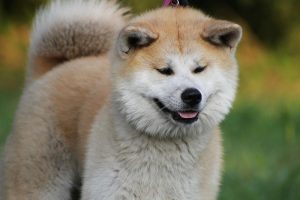When is an Akita Dog Full Grown?
An Akita dog is considered full grown when it reaches its physical and skeletal maturity, which typically occurs between 18 months to 2 years of age. However, keep in mind that individual dogs may vary, and some Akita dogs may continue to fill out and develop muscle mass until they are around 3 years old. The rate of growth and maturity can be influenced by factors such as genetics, nutrition, and overall health. During this growth period, it’s essential to provide proper nutrition and regular exercise to support the dog’s healthy development.

What Impacts the Size of an Akita Dog?
The size of an Akita dog can be influenced by several factors, including:
Genetics: The most significant factor that impacts the size of an Akita is its genetic makeup. The size of the dog’s parents and ancestors will play a crucial role in determining its eventual size.
Gender: Generally, male Akitas tend to be larger and heavier than females. Males can weigh between 100 to 130 pounds (45 to 59 kg), while females typically weigh between 70 to 100 pounds (32 to 45 kg).
Nutrition: Adequate nutrition during the puppy’s growth stage is essential for reaching its full potential size. A balanced diet with appropriate nutrients is vital to support healthy development.
Exercise: Regular exercise and physical activity play a role in the dog’s overall health and muscle development. Proper exercise can help the Akita maintain a healthy weight and muscle mass.
Health: Health issues and medical conditions can affect growth and development. Proper healthcare and early detection of any health concerns can promote healthy growth.
Neutering/Spaying: There is some evidence to suggest that early spaying or neutering can impact growth rates in some dog breeds, including Akitas. Consulting with a veterinarian about the appropriate timing for spaying/neutering can be beneficial.
Environment: The environment in which the Akita is raised can influence its growth to some extent. Factors such as living space, climate, and overall living conditions can impact the dog’s development.
It’s essential to note that while genetics play a significant role in determining the size of an Akita dog, it is also essential to focus on providing proper care, nutrition, and a healthy lifestyle to help them reach their full potential size while ensuring overall well-being.
How Big Do Akita Dogs Get?
The size of Akita dogs can vary, but they are generally considered large and powerful dogs. On average, male Akitas stand between 26 to 28 inches (66 to 71 cm) tall at the shoulder and weigh between 100 to 130 pounds (45 to 59 kg). Female Akitas, on the other hand, are slightly smaller, standing between 24 to 26 inches (61 to 66 cm) tall at the shoulder and weighing between 70 to 100 pounds (32 to 45 kg).
It’s important to remember that these are general size ranges, and individual Akitas may fall outside of these averages. As with any dog breed, there can be variations in size due to genetics, nutrition, and other factors mentioned earlier.
When Do Akita Dogs Stop Growing?
Akita dogs usually stop growing in terms of height and length between 18 months to 2 years of age. At this point, they reach their physical and skeletal maturity. However, it’s important to note that some Akitas may continue to fill out and develop muscle mass until they are around 3 years old.
While height and length growth generally stop by 2 years, the dog’s weight might continue to change slightly depending on factors such as diet, exercise, and overall health. Proper nutrition and exercise during the growth period are crucial for the dog’s healthy development and reaching their full potential size.
When Do Akita Dogs Calm Down?
Akita dogs are known for being independent, strong-willed, and sometimes stubborn, especially during their puppy and adolescent stages. Like many dog breeds, the age at which an Akita will calm down can vary from individual to individual. Typically, Akitas start to mellow out and show more settled behavior as they reach adulthood, which is around 2 to 3 years of age.
During the puppy and adolescent stages, Akitas are energetic and may display exuberant behavior. As they mature, they tend to become more composed and may exhibit a calmer demeanor. However, it’s important to remember that every dog is different, and some Akitas may retain a more playful and energetic personality throughout their lives.
Proper socialization, training, and regular exercise can help promote a balanced temperament in Akita dogs and aid in managing their energy levels. Additionally, consistent and positive reinforcement training can help instill good behavior and obedience in Akitas as they grow older. Always remember to be patient and understanding with your Akita during their development stages to ensure a happy and well-behaved companion.
Do Males and Females Grow the Same Size?
No, male and female Akita dogs do not grow to the same size. As is common in many dog breeds, there is a noticeable difference in size between males and females of the Akita breed.
Male Akitas are generally larger and heavier than females. On average, male Akitas stand between 26 to 28 inches (66 to 71 cm) tall at the shoulder and weigh between 100 to 130 pounds (45 to 59 kg). In contrast, female Akitas are slightly smaller, standing between 24 to 26 inches (61 to 66 cm) tall at the shoulder and weighing between 70 to 100 pounds (32 to 45 kg).
This difference in size is a result of natural sexual dimorphism, where males and females of the same species exhibit different physical characteristics. In the case of Akitas, males are typically more substantial and more robust, while females are generally more compact and lighter. However, individual variations can occur, and some females may be closer in size to the smaller end of the male range.
How To Measure the size of an Akita Dog?
To measure the size of an Akita dog, you will need a measuring tape or a ruler that shows inches or centimeters. Here’s a step-by-step guide on how to measure an Akita’s size:
Height at the Shoulder:
- Stand your Akita on a flat surface with all four feet evenly positioned.
- Find the highest point of the shoulder blade, which is typically located near the base of the neck.
- Place the measuring tape or ruler vertically alongside the dog’s front leg, touching the highest point of the shoulder.
- Measure from the ground up to the highest point of the shoulder. This measurement will give you the dog’s height at the shoulder.
Length of the Body:
- Position your Akita so it is standing straight on all four legs.
- Start at the base of the neck where it meets the shoulder and run the measuring tape or ruler along the spine to the base of the tail.
- This measurement will give you the dog’s length from the base of the neck to the base of the tail.
Weight:
- Weigh your Akita on a scale designed for dogs or visit a veterinarian’s office for an accurate weight measurement.
By measuring your Akita’s height at the shoulder, length of the body, and weight, you can have a better understanding of their size and ensure they are within the typical size range for the breed. Regularly monitoring your Akita’s size is essential to assess their growth and overall health. Remember that Akitas should be well-proportioned and balanced in their size, so variations from the breed standard might indicate potential health or nutrition concerns. If you have any doubts about your Akita’s size or health, it’s always best to consult with a veterinarian.
Akita Dog Life Expectancy
The life expectancy of an Akita dog typically ranges from 10 to 15 years. However, as with any breed, individual factors such as genetics, diet, exercise, and overall healthcare play significant roles in determining a dog’s lifespan.
Providing your Akita with proper nutrition, regular exercise, routine veterinary check-ups, and a safe and loving environment can contribute to a longer and healthier life. Additionally, responsible breeding practices that aim to minimize genetic health issues can positively impact the overall longevity of the breed.
It’s important to be aware of common health issues that can affect Akitas, such as hip dysplasia, progressive retinal atrophy (PRA), hypothyroidism, and certain immune-related disorders. Regular health screenings and early detection of any health concerns can lead to appropriate management and potentially extend your Akita’s lifespan.
Always consult with a veterinarian for personalized advice on caring for your Akita and promoting their overall well-being throughout their life.
Fun Facts About Akita Dogs
Certainly! Akita dogs are a fascinating breed with a rich history and unique characteristics. Here are some fun facts about Akita dogs:
Japanese National Treasure: The Akita is a native breed of Japan and is considered a national treasure in the country. They are highly regarded for their loyalty and bravery.
Hachiko, the Legendary Akita: One of the most famous Akitas in history is Hachiko, a dog known for his unwavering loyalty to his owner. He waited at a train station every day for nearly 10 years after his owner’s death, symbolizing loyalty and devotion.
Bear-Like Appearance: Akitas have a distinctive bear-like appearance, characterized by their large, broad heads, small, triangular eyes, and thick double coat.
Akita Inu vs. Akita Americano: There are two main types of Akitas: the Akita Inu (Japanese Akita) and the Akita Americano (American Akita). While both are similar in appearance, they have some subtle differences in size, coat color, and temperament.
Warm Coats: Akitas have a dense, plush double coat that provides insulation in cold weather. This thick coat helps them tolerate harsh winter climates.
Ancient Breed: The Akita breed is believed to be one of the oldest native Japanese breeds, with a history dating back hundreds of years.
Samurai Dog: Akitas were historically bred for various purposes, including hunting large game and guarding Japanese royalty. They were even known to be companions of samurai warriors.
Akita Tail Curl: A unique trait of Akitas is their curled tail that rests over their back. This tail curl is an identifying characteristic of the breed.
Good with Family: Akitas are known for their loyalty and protective nature towards their families. They can be excellent watchdogs and are generally good with children if properly socialized and trained.
Powerful Bark: Akitas have a deep and powerful bark, which can serve as a deterrent to potential intruders.
Independent Thinkers: Akitas are intelligent and can be independent thinkers, which may sometimes make training challenging. Consistent and patient training methods work best with this breed.
Love for Water: Despite their thick coat, many Akitas enjoy swimming and playing in water, which is not common for all dog breeds.
Remember that while Akitas have many endearing qualities, they are a strong and powerful breed that requires responsible ownership, socialization, and training. As with any dog, it’s important to understand their specific needs and provide a loving and supportive environment to ensure a happy and well-adjusted companion.
Akita Dog Full Grown: Frequently Asked Questions
When is an Akita dog considered full grown?
An Akita dog is considered full grown when it reaches its physical and skeletal maturity, typically between 18 months to 2 years of age.
How big do Akita dogs get?
Akita dogs are generally large and powerful. Male Akitas stand between 26 to 28 inches (66 to 71 cm) tall at the shoulder and weigh between 100 to 130 pounds (45 to 59 kg). Female Akitas are slightly smaller, standing between 24 to 26 inches (61 to 66 cm) tall and weighing between 70 to 100 pounds (32 to 45 kg).
When do Akita dogs stop growing?
Akita dogs usually stop growing in terms of height and length between 18 months to 2 years of age. However, some Akitas may continue to fill out and develop muscle mass until around 3 years old.
When do Akita dogs calm down?
Akitas tend to become more composed and calm as they reach adulthood, which is around 2 to 3 years of age. However, individual dogs may have variations in temperament.
Do male and female Akitas grow to the same size?
No, male and female Akitas do not grow to the same size. Males are generally larger and heavier than females.
What factors impact the size of an Akita dog?
The size of an Akita dog can be influenced by genetics, gender, nutrition, exercise, health, neutering/spaying, and environmental factors.
How can I measure the size of my Akita dog?
To measure the size of an Akita, use a measuring tape or ruler. Measure the height at the shoulder and the length of the body from the base of the neck to the base of the tail.
What is the life expectancy of an Akita dog?
The life expectancy of an Akita dog typically ranges from 10 to 15 years, depending on factors such as genetics, diet, exercise, and healthcare.
Are Akitas good family dogs?
Akitas can be loyal and protective of their families, but they require early socialization and consistent training to ensure they are well-adjusted and well-behaved family members.
What are some fun facts about Akita dogs?
Akitas are considered a Japanese national treasure, known for their bear-like appearance, and were companions of samurai warriors. The legendary Akita, Hachiko, symbolized loyalty and devotion. They also have a unique curled tail and a powerful bark.
Conclusion
In conclusion, the Akita dog is a remarkable breed with a rich history and unique characteristics. They are known for their loyalty, bravery, and protective nature, making them excellent companions and watchdogs. Akitas are considered a Japanese national treasure and have been part of Japan’s history for centuries.
These majestic dogs have a bear-like appearance with a dense double coat that helps them tolerate cold weather. While Akitas are strong and powerful, they also have a gentle and loving side, especially towards their families.
It’s essential to understand that Akitas require proper training, socialization, and responsible ownership to ensure they develop into well-behaved and well-adjusted pets. They reach their full-grown size between 18 months to 2 years, with males generally being larger than females.
Overall, Akitas can live for around 10 to 15 years with proper care and attention. Their loyalty and devotion make them wonderful family members, and their unique characteristics make them fascinating and beloved companions. Whether they are guarding their loved ones or playing in the water, Akitas have a special place in the hearts of many dog lovers around the world.






